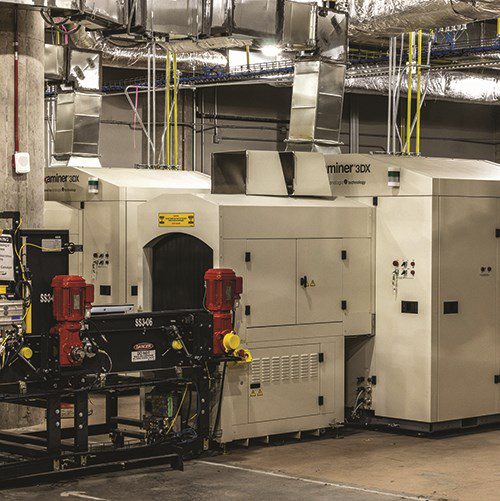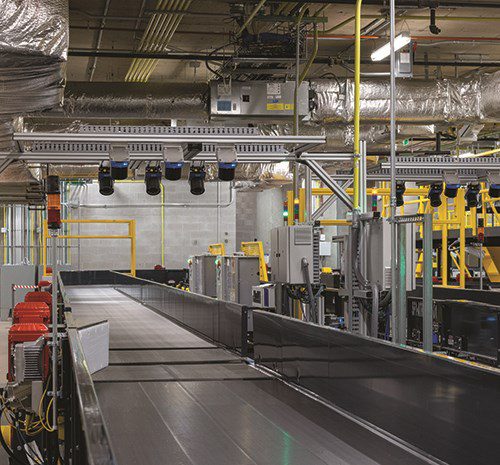When a baseball or soccer team performs above expectations, sportscasters sometimes say, “The whole is greater than the sum of its parts.” Arguably, the same could be said about the new South Concourse 1 of Terminal 4 at Phoenix Sky Harbor International Airport (PHX). With a price tag of $310 million, the new 130,000-square-foot concourse is scheduled to open this summer with eight additional gates, all operated by Southwest Airlines.
When a baseball or soccer team performs above expectations, sportscasters sometimes say, “The whole is greater than the sum of its parts.” It’s not a knock against the individual athletes, but rather a statement about the synergy that occurs when top athletes work together. Arguably, the same could be said about the new South Concourse 1 of Terminal 4 at Phoenix Sky Harbor International Airport (PHX). With a price tag of $310 million, the new 130,000-square-foot concourse is scheduled to open this summer with eight additional gates, all operated by Southwest Airlines.
 Airport officials are already touting the new concourse’s high performance and seamless travel experience for users, and they attribute both to the quality of its individual components and systems. In other words, the whole is directly attributed to the sum of its stellar parts.
Airport officials are already touting the new concourse’s high performance and seamless travel experience for users, and they attribute both to the quality of its individual components and systems. In other words, the whole is directly attributed to the sum of its stellar parts.
One particularly important “part” of Terminal 4 South Concourse 1 is a high-tech baggage handling system that will serve it and the other three south concourses in Terminal 4. When planning the new baggage system, the project team focused on finding a design that would enhance the travel experience into and out of PHX for years to come.
|
Project: New Baggage Handling System Location: Phoenix Sky Harbor Int’l Airport Site: Terminal 4 South Concourse 2 System Will Service: All 4 concourses in Terminal 4 South, including new South 1 Concourse Airport Owner/Operator: City of Phoenix Project Timeline: May 2019-June 2022 System Online: April 2022 Total Cost of Concourse Project: $310 million Key System Components: 5 EDS machines, with room for 6th; additional room also available for 6th sortation carousel for outbound baggage makeup; inbound carousel for Terminal 4 baggage claim; conveyor system to transport bags Unusual Elements: 4 tunnels for system conveyors & 2 passenger walkway bridges General Contractor: McCarthy Building Companies Architect: SmithGroup Corgan joint venture Baggage Handling System Design: BNP Associates Baggage Handling System Construction/Installation: G&S Airport Conveyor General Transport & Queue Conveyors; Check-In Conveyor; Inclined Carousel Conveyor; Vertical Sortation Units: G&S Airport Conveyor High-Speed Diverters: Siemens Baggage Drive Motors: SEW Power Curves & Merges: Interroll-Portec Automatic Tag Readers & Bag Dimensioners: SICK Key Benefits: Ethernet platform facilitates high-capacity, high-speed baggage handling, increased reliability & cost-efficient maintenance; locating new system in existing basement in South Concourse 2 eliminated need to excavate & build basement facility in new South Concourse 1; retains ability for all Southwest Airlines bags to be processed in single location |
“All the airlines are expanding, so they need more capacity. They need more reliable systems,” says Jerry Oakes, section head for the Baggage Handling System/EDS Department at PHX. “We have to be looking at five to 10 years down the road as far as the growth of the airport. It’s just something that we always have to try to stay ahead of so we can keep up with the demand of the passenger and luggage counts.”
Other features that contribute the concourse’s impressive whole include a diverse collection of restaurants and retail shops, popular passenger amenities such as charging stations and a common-use lounge, and a new connector bridge to the north concourses in Terminal 4.
Unsung Hero
But back to the baggage system. In general, baggage handling systems usually go unnoticed by travelers until they don’t work as designed. This “quiet hero” aspect suits the key decision-makers in the PHX Terminal 4 project just fine. They pored over design and model options carefully, intent on creating a baggage handling system that provides passengers only positive reasons to take notice.
For the overall concourse project, PHX entered a construction management-at-risk contract with general contractor McCarthy Building Companies. Design was handled by a joint venture of Detroit-based SmithGroup and Corgan, an architectural firm with extensive experience in the aviation industry.
Because PHX is owned and operated by the city of Phoenix, the City Council had to approve construction of the eight-gate concourse. The airport secured that approval in October 2016, and enabling projects began in 2019. Airport officials, working closely with project leads from McCarthy and baggage system designer BNP Associates, determined that the best plan was to house the baggage handling system in a basement of the Terminal 4 South Concourse 2, the concourse that includes the D gates 1 through 8.
Brandon Moon, project executive for McCarthy, notes that using the construction manager-at-risk model allowed cohesive team collaboration. “We had one goal: mitigate challenges and create a swift review/approval process as the project progressed,” he explains.

“The biggest role we played was assessing the feasibility of the space and providing real-time cost to the airport and to the design team to make sure each solution was vetted before we went too far down that path,” Moon continues. “As they would come up with solutions, we had our design phase service team pricing all of those options in real time. It was amazing how the teams worked together.”
The original plan called for a full basement underneath the new concourse to house the TSA explosives detection system (EDS) equipment and conveyors. But the construction management-at-risk model made it reasonable to explore other possible solutions.
“We tried options where we would add a supplemental baggage handling system to their existing one on the other side of the terminal…we tried a new one that would potentially be underground between the two concourses…and we tried one that would be in existing space in the South 2 Concourse,” recalls Asher David, associate director for BNP Associates in Denver. “We developed high-level concepts for each of them.”

After comparing cost, functionality, potential disruption of the existing system during construction, and other pros and cons, it was clear that the best option was to build an entirely new system in the basement of the South 2 Concourse rather than the new South 1 Concourse.
Using the existing space eliminated the need to complete extra excavation in the new concourse, as well as construct concrete basement walls, ensure waterproofing and tackle everything else involved with building a new basement. The only significant enabling project required to use the existing basement in South 2 was building new office space for the airport facilities and maintenance personnel who occupied that space at the time.
“They cleared it out so it was a completely cavernous basement, and then we designed the baggage handling system in that space to replace most of the existing system that Southwest was using to serve Terminal 4 South,” explains David.
After the location was determined, the conveyor delivery system was designed to feed baggage to five EDS machines and meet the concourses’ overall throughput needs. With an eye toward growth, the system has room to add a sixth EDS machine if necessary. There also is room for a sixth sortation carousel for outbound baggage makeup.

Tunnel Vision
Locating the new baggage handling system in South Concourse 2 required PHX to construct four tunnels (totaling approximately 700 linear feet) to accommodate system conveyors that serve the four South Concourses at Terminal 4. Conveyors supplied and installed by G&S Airport Conveyor transport checked baggage from ticketing counters to the EDS machines and then route each to its respective concourse for loading onto aircraft.
 “Construction of the conveyor system was phased around the completion of the tunnels,” says G&S Project Manager Randy Dirks.
“Construction of the conveyor system was phased around the completion of the tunnels,” says G&S Project Manager Randy Dirks.
In total, it took about 1,200 cubic yards of concrete to build the various tunnels, which ranged in length from 70 to 380 feet. Moon notes that the project team used a cut-and-cover system to build the tunnels. “The slab of the tunnels was approximately 20 feet below grade, adjacent to existing airport operations, thus requiring a robust shoring system,” he explains. “We would dig down in 4-foot lifts, install tiebacks and place shotcrete over the exposed face of the excavation and repeat the sequence until they reached subgrade. This allowed the concrete tunnels to be constructed while providing a safe working environment for crews and the adjacent airport operations.” In addition to being the most cost-effective method, this minimized the amount of excavation and backfill needed, he adds.
Mapping a route for the conveyors through the network of existing mechanical, electrical and plumbing systems was a challenge that required G&S to coordinate carefully with McCarthy. “There are 25-year-old systems that a lot of this conveyor had to weave through,” Dirks comments. “It’s sort of threading the needle.”
The new baggage handling system includes about 1.5 miles of conveyor belts.

Upgrading to Ethernet
Another major challenge encountered during the project was integrating the Ethernet communications platform that is the backbone of the new baggage system with the DeviceNet protocol that ran the existing baggage system. Dirks explains that Ethernet can transfer data significantly faster than DeviceNet. In addition, Ethernet is generally considered to be more cost-effective to maintain than older systems because off-the-shelf components are more readily available, and technicians are more familiar with an open protocol than a proprietary version.
Officials decided to upgrade components of the to-remain existing baggage system to Ethernet so the entire system would be on the same controls platform. Dirks is confident it was the right decision to make for the maintenance and long-term feasibility of the system.
 Eric Miller, senior project manager with McCarthy, agrees that upgrading the existing system to Ethernet was the right call. “The technology is advancing in real time, and we’re finding out that DeviceNet is no longer being used; so airports all across the country will eventually have to do this. The speed and ease of using Ethernet creates a more reliable system.”
Eric Miller, senior project manager with McCarthy, agrees that upgrading the existing system to Ethernet was the right call. “The technology is advancing in real time, and we’re finding out that DeviceNet is no longer being used; so airports all across the country will eventually have to do this. The speed and ease of using Ethernet creates a more reliable system.”
Oakes notes that the airport is considering upgrading to Ethernet operating systems in other concourses at PHX.
The real test for all of the systems and “parts” will come this summer, when the new South Concourse 1 officially opens. Members of the project team report that the baggage handling system went live in early April and was processing approximately 10,000 bags per day.


 facts&figures
facts&figures

